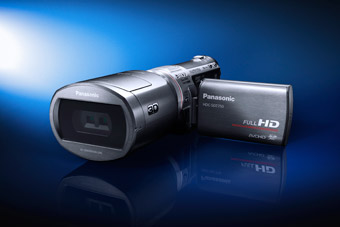Establishes '3D Innovation Center' as a Test Bed for Production Techniques
That’s a potential solution for broadcasters who need a mid-sized 3D-ready production environment. They should also benefit from the experience Panasonic and Bexel gain over the next two weeks, as they work with CBS Sports to capture U.S. Open tennis matches in stereo 3D. CBS Sports Executive Vice President Ken Aagaard discussed some of the established rules of 3D sports shooting, including the adoption of more low camera positions and showing additional restraint in cutting between camera angles. The U.S. Open is a great opportunity for working in 3D, he noted, because of the unusually confined field of action on a tennis court.
The Shadow (Camera) Knows
But it’s also a challenge. Some of the important camera positions on court don’t have room for the second camera operator who would normally be required on a 3D rig. Enter 3D shooting guru Vince Pace, whose Shadow D rig was used on ESPN’s X Games broadcast from Los Angeles in July. Essentially, as Aagaard described it, it’s a standard video camera with two 3D cameras mounted on top of a special housing built around the 2D lens. The rig is programmed so that, when the camera operator makes adjustments to the 2D lens, they are automatically translated and applied to the 3D cameras and lenses. Pace and NEP Broadcasting were brought in to help produce the 3D broadcasts, he said.
To help address similar challenges, Panasonic announced the formation of a "3D Innovation Center" to open this fall at Panasonic’s headquarters in Secaucus, NJ, dedicated to reviewing technology and establishing guidelines for best practices in 3D acquisition, production, post, and delivery. A Los Angeles branch will also be established. (A similar Panasonic "3D Innovation Center" was established in Japan earlier this year.)
The company also took the opportunity to remind attendees that a whole raft of stereo-3D products just hit the market, including its AG-3DA1 3D camcorder ($21,000), which started shipping last week. The new BT-3DL2550 3D LCD monitor ($9,900) is also available now, and the AG-HMX100 live 3D switcher ($5,800) should be available later in September.

3D Home Movies
Also new was the company’s recently announced 3MOS consumer-level 3D camcorder, the $1399 HDC-SDT750 [pictured above]. Think of it as an AVCHD camcorder that comes with a special "3D conversion lens" attachment. Basically, the conversion lens captures two separate images, recording them to the camera’s MOS sensors in a side-by-side configuration. Connected to a compatible 3D TV (via HDMI mini cable or SD memory card), the footage will be played back in stereo 3D. If you twist off the converter, you’re ready to shoot a standard HD image in 2D.
Will the HDC-SDT750 become popular with pro stereo videographers as a sort of inexpensive "crash cam," the way light and inexpensive HDV cameras caught on as a source for B-roll that could sometimes be intercut with footage from much more expensive HD cameras? Probably not — Panasonic 3D technology performed very well in the company’s special stereo exhibit room at the U.S. Open, but footage captured with the SDT750 was an obvious step below professional-level footage, in part because of the consumer-quality imager and also because the side-by-side acquisition method limits the recorded imagery to just half of HD’s horizontal resolution. However, a live display showing footage being captured in real time with the AG-3DA1 was very convincing in terms of pleasing 3D effects, albeit under tightly controlled shooting conditions.
Sections: Business Technology
Did you enjoy this article? Sign up to receive the StudioDaily Fix eletter containing the latest stories, including news, videos, interviews, reviews and more.